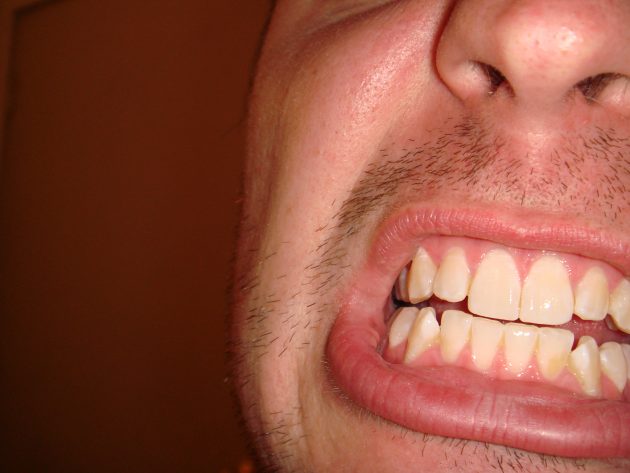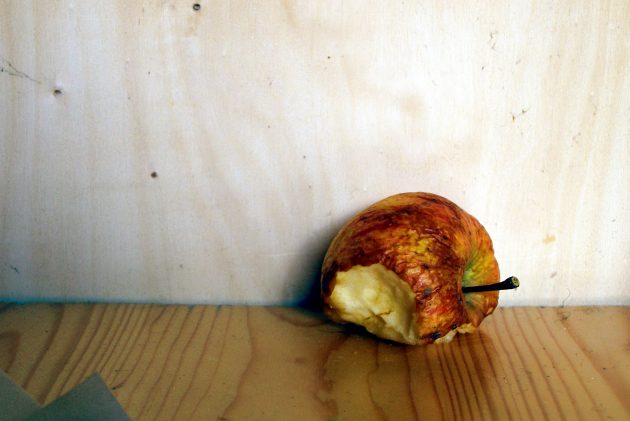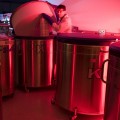By John Barrat
A bite mark on a homicide victim’s skin is not an unusual discovery. A criminal’s teeth marks are also occasionally found on food at a crime scene. Once a suspect is apprehended detectives may begin trying to match a suspect’s teeth with impressions left on a victim’s skin or on food collected as evidence. With luck, a good match might help place a suspect at the scene of the crime, but it’s often a stretch.
“In bite-mark analysis impressions are not always unique enough for positive identification,” says Sara C. Zapico, research collaborator in the Anthropology Department of the Smithsonian’s National Museum of Natural History. “Even with the recent use of computer matching, distortions of bite impressions left on skin or a food item often make a match impossible.”

During biting, saliva is usually deposited by the teeth and lips in enough quantity to allow its later collection and use in DNA typing. (Flickr photo by Greg O’Connell)
During biting, however, something more than bite marks is left behind that also can link a suspect to a crime: saliva. Floating in saliva are skin cells from the cheek interior and white blood cells (leukocytes); each cell contains an individual’s unique DNA.
During biting, saliva is deposited on an object or on a victim’s skin by the teeth and lips and it usually occurs in enough quantity to allow its collection and DNA typing, Zapico says.
In a new study in the Archives of Oral Biology, Zapico and co-author Sofia T. Menéndez of the University of Oviedo in Spain, show that it is quite possible to recover and isolate DNA from saliva on bitten foods, even some 15 hours after the saliva has dried.
“Quantity and purity of DNA often depends on food type,” Zapico explains. Few previous studies have shown great success in isolating human DNA from foods displaying bite marks.

Ample saliva was collected from the apples in the study, but acidic compounds in the apple’s juice deteriorated the DNA while it was at room temperature. No quality DNA was amplified from the apple. (Flickr photo by Erich Ferdinand)
In their study three volunteers bit samples of Manchego cheese, chocolate doughnuts and Fuji apples. To replicate crime scene conditions, the food was left untouched at room temperature for 15 to 16 hours before it was collected and frozen at -15 Celsius. Next the items were taken to a lab, thawed, and the area around the bite marks was wiped with a sterile cotton swab moistened with distilled water. A second dry swab was used to collect any moisture that remained from the first swab. The swabs were then sealed in sterile tubes.
Next Zapico and Menéndez isolated the DNA by applying a silica-based procedure (a simple and straightforward technique that is less laborious than the classical Phenol-Chloroform DNA extraction and which avoids toxicity, Zapico says). By conventional polymerase chain reaction, two constant genes from the DNA were amplified, GAPDH and RPL22, commonly known as housekeeper genes, which are required to maintain basic cellular function. These genes are similar to those used to define an individual’s unique nuclear DNA.
“The cheese and doughnut preserved the best quality of nuclear DNA, it was highest in cheese,” Zapico says. “The cheese was solid and firm and the saliva stayed on its surface and because the doughnut was porous it absorbed the saliva. Ample saliva was collected from the apple but acidic compounds in its juice deteriorated the DNA while it was at room temperature. No quality DNA was amplified from the apple.”
The researchers also detected and amplified human mitochondrial DNA from all the food types. Theirs is the first research study to achieve this. While it is not as useful as nuclear DNA in identifying individuals, mitochondrial DNA can be valuable in establishing matrilineal kinships (descent through the female line) in forensic investigations, molecular anthropology, biographic ancestry and human genetics.
“One of the improvements in our paper over other similar studies was the amount of salivary DNA we recovered from our samples because we used two swabs, both wet and dry—the double-swab technique,” Zapico points out.

Matching bite marks in food at a crime scene to a suspect’s teeth is often a stretch. Saliva deposited on the food and subjected to DNA analysis, however, has the potential to strengthen the positive identification of those present at a crime. (Flickr photo by Jacovn117*)
Different factors affect the quantity and quality of saliva that might be collected at a crime scene, the researchers say. For example, a person’s salivary stimulation prior to a bite, and the size of an individual’s salivary glands can mean more or less salivia. Time of day may also be a factor as some studies indicate human saliva flow increases slowly in the morning, peaks in the afternoon and is lowest during sleep. In this test the volunteers bit the food in early morning.
According to Zapico and Menéndez, their new work is clear proof that should a bite mark at a crime scene warrant an attempt to match the impression, collecting and isolating salivary DNA from the bite area also should be carried out. Combined, these two forms of evidence increase the possibility of correctly identifying a criminal.
Zapico is hopeful that soon the techniques used in this study might be accepted as evidence in an actual courtroom trial. “Now we need to validate what we have done with more work. Our next steps will be using more types of foods and exploring broader scenarios than those in this paper. We need to get moving on more studies,” she says.





